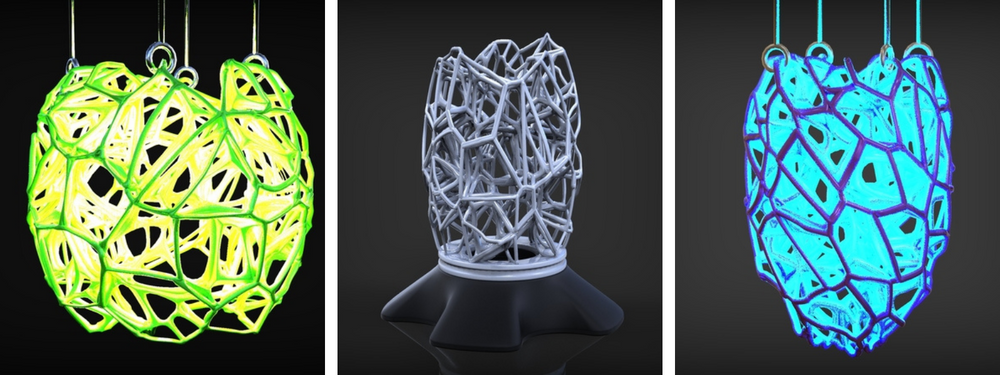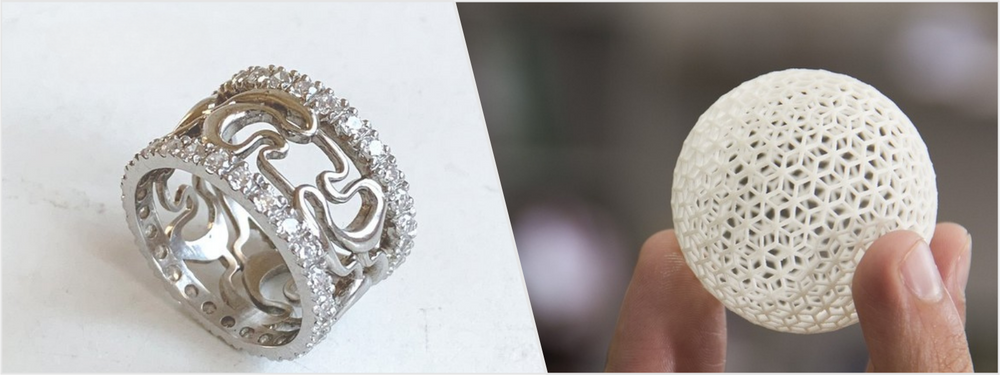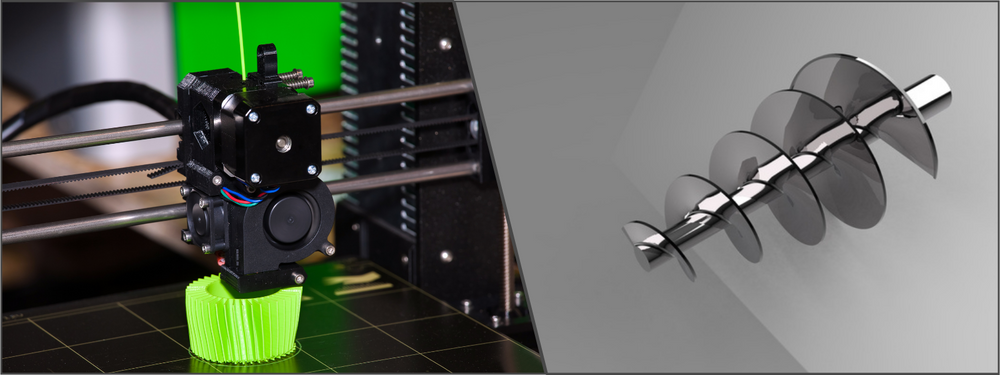Threads seen on fasteners like screws and nuts convert the rotational motion of their helical structure into linear action. The helical structure features grooves or ridges in a spiral orientation for the rotation. The groove must be deep enough to prevent the fastener from sliding in and out when applying linear force. Every type of fastener has specific leads and head shape to provide mechanical advantage, ease of use, and sometimes for aesthetic purposes.
 Table of Contents
Table of Contents
3D printed threads
Anyone who has repaired or built something mechanical – from opening a battery cap on a TV remote to engine assembly – is undoubtedly familiar with many types of bolts, nuts, and screws. You can purchase a large variety from hardware stores everywhere. In the United States and Canada, the unified thread standard (UTS) ensures that all fasteners sold in the country, regardless of the manufacturers, are compatible with all others of the same size.
Threaded fasteners like bolts, nuts, and screws are typically made of metal materials; some are plastic. Metals like steel and titanium are preferable for their strength and corrosion resistance. Other metals like brass and bronze are sometimes used for the electrical conductivity advantage, and some are gold-plated for cosmetic appeal.
From the perspective of practicality, it makes little sense to create 3D-printed screws and threads. Metal fasteners are reliable, easily accessible, and affordable; tons are readily available. The key benefit of 3D printing a fastener is the unlimited customization options. It will be a wasteful endeavor unless you want to create a custom-shaped fastener with personalized specifications.
No other technology has given the level of design freedom that 3D printers have. Now that they are getting more affordable, the filaments, custom threads, and screws are feasible design options. Assuming your product has enough tricky mechanical parts, unique bolts and nuts of non-standard sizes may be required. 3D printing offers the solution to the problem.
RELATED: 6 Ways 3D printing will change the world

Popular 3D printers
A threading mill shaves off the base material in subtractive manufacturing methods until the desired shape is achieved. Since 3D printing implements an additive manufacturing principle, the process runs in reverse. Instead of removing bits of materials, the printer extrudes the filament onto a print bed to form the fastener. That said, not every 3D printing method is created equal.
Fused deposition modeling (FDM) is a standard and affordable method of 3D printing. FDM can produce smooth, high-quality threads for plastic filaments thanks to its dimensional stability. Other methods, such as laser sintering and resin-based methods, aren’t as good.
Laser powder bed fusion (LPBF) and binder jetting are superior when using metal filaments. Metal 3D printers are costly. Among the latest lowest-price options is Metal X from Markforged; it costs just shy of $100,000. The metal 3D printer works similarly to FDM, where it extrudes metal powder and wax binder, and further processing is necessary to remove the binder and produce actual metal parts. On the higher end of the spectrum is the Velo3D Sapphire (LPBF), which costs upwards of $500,000. Mid-range options include several LPBF-based GE additive machines ($250,000) and the binder jetting HP Metal Jet ($399,000).
Basics of 3D printing fastener threads
Before diving deeper into the basic process of 3D printing threads and screws, it might be helpful to get familiar with some fastener-related terms:
- Handedness: the thread helix orientation (clockwise and counterclockwise)
- Form: the shape of the thread
- Thread angle: the geometry of the thread angle
- Root: the bottom of the ridge or groove
- Crest: the highest point of thread shape or profile
- Pitch: the distance between one crest to another
- Major diameter: the diameter measured from the crest (external/male thread)
- Minor diameter: the diameter measures from the root (external/male thread)
Major and minor diameters in an internal/female thread are measured from the root and crest.
Support Material
Most low-end 3D printers require a support structure on the print bed. A 3D-printed part is created one layer at a time. Each layer is built upon the previous one, so the support structure and its orientation can affect the amount of material or filament used for the printing. 3D printing the threads vertically, perpendicular to the print bed, is best to minimize the size of the support structure necessary. Since you don’t have to remove support material from the threads at the end of the process, the surface finish should be acceptably smooth.
Support material is required to 3D print parts with an overhang smaller than 45 degrees. Such a steep overhang causes sagging, which makes the part essentially unprintable. If the thread angle is larger than that, you might not need support material; the previous layer provides enough support for the overhang in the new layer.
That said, some metal 3D printers in the mid-range to high-end categories can print any shape with an overhang down to 20 degrees without support, for example, the DMP Flex 100 from 3D Systems. In the case of Velo3D Sapphire, support is unnecessary as the 3D printer can achieve prints of zero degrees overhang; it will print flat surfaces on a horizontal plane without a problem.
Zero support is the best approach to 3D printing threads, both external and internal. If you must use a support structure, mind the printing orientation and ensure no material goes inside the thread. The post-processing job after the printing, in which you must remove the support material, can damage the finish and render the fastener unusable.
As always, make sure the extruder is calibrated correctly before 3D printing. While calibration is essential in all 3D printing tasks, it is indispensable when the object is a threaded fastener. Not only do you want a smooth finish but also a functional mechanical part. Under and over-extrusion may cause poor details, stringing, blobs, and filament jamming.
RELATED: 6 ways you can use 3D printing services to create a new prototype design

Layer Height
Another critical parameter is layer height, which refers to the size of each layer of filament extruded. It is the thickness of the layer and part of the Z resolution. As a rule of thumb, a smooth operation requires the layer height to be as low as possible. Threads larger than half an inch (M12) require a 0.2mm layer at most; smaller threads must be 3D printed at thinner layers. The LBPF method can reach a layer height of 0.02mm, FDM at 0.05mm, and binder jetting at 0.035mm.
Lower layer height means the ability to 3D print more layers to create a specific part. A higher amount of layers (and materials) also allows for a better surface finish. However, the 3D print time increases. In many 3D printing company processes, it is always about finding a balance between quick turnaround and smooth results. Regardless of the type and shape of the threads, it is best to set the layer height to the 3D printer’s lowest setting. At 50 µm using the FDM method, the result is supposed to be acceptable for most applications.
Post-Processing
Post-processing is only necessary when you have to remove excess materials. When the filament is plastic, you can use a pick or a pair of pliers to remove the support structure. 3D printing the fastener vertically minimizes the chances of support material getting inside the threads. Otherwise, removing the materials from fine threads can be a real struggle without damaging the parts.
Metal powder is trickier than plastic filament, and the 3D-printed part often requires additional equipment to ensure a fine finish. For example, Metal X requires two post-processing components, including Wash-1 to remove the wax binder and Sinter-2 to solidify the powder. Most metal 3D printers of any price range require additional post-processing equipment, usually sold separately.
RELATED: A brief history of 3D printing

Considerations
- Internal threads with a diameter smaller than 4mm also have a small pitch, making them tricky to print. It might be easier to 3D print a hollow part and cut the threads using a tap wrench.
- Loose threads on a male fastener and overly tight ones in a female screw are not uncommon. Some filaments shrink even during 3D printing, and it is best to create small samples before printing larger parts.
- Plastic 3D-printed screws and fasteners, especially those with smaller threads, are most likely used for decorative purposes. They are not meant to carry weight or provide mechanical engineering support, except to a small degree. Anything smaller than M6 might be more of an aesthetic than a functional part. On the other hand, metal 3D-printed fasteners can be functional and aesthetically pleasing with a custom 3D design.
- Plastic 3D fasteners might work for small, lightweight products such as toys or simple household items without moving parts or internal mechanisms.
As mentioned, 3D printing standard-sized threads and screws without customization are wasteful, expensive, and do not add value to the product. The most significant advantage of 3D printing screws, nuts, and bolts is the freedom of CAD design, which means you can create a unique fastener with outrageous detailing. In that case, 3D printing offers both time-saving and cost-efficiency benefits.
How Cad Crowd can help
Innovative product design options, such as 3D-printed threads and screws, can potentially transform how companies develop and manufacture their products. Cad Crowd specializes in high-quality CAD drafting, CAD design, 3D modeling, patent services, and more. Our leading online marketplace can connect you with skilled professionals who can help you bring your creative ideas to life. Don’t miss out on the opportunity to stay ahead by integrating cutting-edge design solutions.
Contact us today to know how it works or get a free quote and explore the possibilities of 3D-printed threads and screws for your company.
